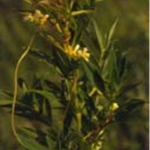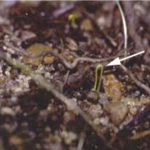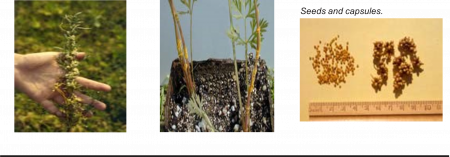Dodder (2001)
Common or swamp dodder (Cuscuta gronovii Willd.) is the most prevalent and abundant species of dodder in North America. Its range extends from Maine and Nova Scotia to Florida and westward through Canada and the Midwest. It is more abundant in the central and northeast regions of the United States (Yuncker, 1965). It is an obligate parasite, consisting of yellow twining stems that produce small clusters of white flowers (Parker and Riches, 1993). Dodder can establish parasitic relationships with many agricultural hosts, including cranberry (Vaccinium macrocarpon Ait.), blueberry (Vaccinium spp.), alfalfa (Medicago sativa) and clover (Trifolium spp). It is also capable of infecting many other dicotyledonous weeds and wild plants (Dawson et al., 1994). Botanists classify this group of parasitic plants either as one of over 50 genera in the family, Convolvulaceae (as per Yuncker), or place them as a single genus in their own family, Cuscutaceae (Gleason and Cronquist, 1991). Yuncker described approximately 150 species of Cuscuta, while Gleason and Cronquist described approximately 15 species. The lack of distinctive stem characteristics, absence of leaves and roots, and the presence of very small flowers, make these plants very difficult to classify. Dodder is an organism that is prevalent in disturbed habitats, which promotes their function as serious weeds (Dawson et al., 1994). For example, C. gronovii is described as growing along stream margins, areas of continual erosion. Their adaptation to disturbed habitats enhances the survival capacity of many Cuscuta species in modern agroecosystems. Dodder is considered to be a very serious pest in commercial cranberry production, capable of reducing yields by at least 50% (Bewick et al., 1988) and sometimes as high as 80 to 100% (Devlin and Deubert, 1980). Control of dodder remains challenging for cranberry growers. Many management options available to growers of annual crops (e.g., altering time of planting, crop rotation, etc.) are not possible in perennial systems. Preemergence herbicides are currently available for control of dodder. Research has shown that cultural practices, such as uniform applications of sand (Sandler et al., 1997) may inhibit germination of dodder seedlings. In contrast, studies have shown that late water floods are not effective for control of dodder. Combining chemical and cultural strategies may offer the best solution for suppressing dodder in cranberry production (Sandler, 2001).
General Description
Dodder is an annual plant known by several common names, such as strangle weed, angel’s hair, and golden thread (Yuncker, 1965). Seedlings consist only of stem tissue and have no leaves or roots. Stems are slender strands, usually yellow to orange in color. Even though dodder relies on its host for life-sustaining nutrients, some species may contain very small concentrations of chlorophyll. Dodder is classified as an annual plant (completes its life cycle in one season). However, it can overwinter as haustoria (specialized structures that transport nutrients from the host to the parasite) if the stems of the infected host plant live through the winter.
Life Cycle and Dispersal
Dodder is an obligate parasite; it cannot complete its life cycle alone. It must form a successful attachment to a host to live beyond the seedling stage. When the seedling finds a suitable host, it will twine around the stem. Dodder will penetrate the susceptible tissues of the host and produce specialized absorption structures called haustoria. It then loses contact with the ground and lives totally off the host plant. If an acceptable host is not nearby or is not colonized, the seedling will die. Within 2 to 4 days after the seedling has twined around the host, haustorial swellings can be seen (MacLoed, 1961). Haustoria have a high level of growth activity. Even if all exterior portions of the dodder plant are completely removed from the host, the embedded haustoria can remain alive. New stem tissue can be subsequently generated from the embedded haustoria. This phenomenon reinforces the need for complete removal of infected hosts far away from the bog area. Dodder reproduces by seed, but these are not easily dispersed by animals or wind. The fruiting capsule has a large amount of air space and can be buoyant. Consequently, the major means of dispersal is by water or by human activities. For example, water harvesting has significantly increased the dispersal and occurrence of dodder in Massachusetts over the past several decades. Seed can also be spread through the irrigation system if the water is contaminated with dodder. Dodder stems and seeds, as well as infected hosts, can also be spread in mowed or pruned vines received from other bogs. Care should be taken to fully investigate the presence of any existing dodder infestations prior to the purchase of vine cuttings.
Seeds and Seedlings
Seeds of C. gronovii are very tiny (0.5-1.0 mm diameter), gray to brown in color. They are irregularly round in shape. The seed coat is very hard and has a rough surface. Several tiny seeds (ca. 2-4) may be present within a single fruit capsule. Only a small percentage of the seed population in the soil may germinate in any single season. It is thought that seed can remain viable for many years. Research initiated in 1997 at the UMass Cranberry Station indicates that dodder seed collected from Massachusetts cranberry farms remains viable at least 4 years after planting (Sandler, unpublished data). Thus, once a farm is infested, it can remain infested for many years. Most seedlings emerge from a depth of 0.5-1.0 inch of soil. Seedlings are rootless and leafless, consisting a thin, yellow, threadlike stem. They emerge as an arch (see photo on front page), straighten out and then begin to twist in a counterclockwise direction (circumnutation). At this point, they can contact a vertical host and twine around it. Often, newly emerged seedlings are rather difficult to find on the bog floor. It is preferable to look for them in thinly vined or bare areas of the bed.
Shoots
After attaching to the host, new shoots will develop from the portion of the dodder seedling that is twined around the host. These stems grow rapidly and re-attach to the host plant. Dodder may attach itself many times to the same host or branch off to attach to different hosts. If a seedling does not contact a suitable host, it will continue to elongate. The growing tip will remain succulent and viable while the basal portion will begin to senescence and wither. Greenhouse studies (Sandler et al., 1997) indicated that unattached seedlings could survive (as determined by visual observation) for a maximum of 50 days, though most seedlings survived 3 to 9 days after emergence. However, this research did not verify the ability of these older seedlings to successfully attach to a host. Note also that field conditions tend to be more harsh than greenhouse conditions and would presumably shorten the longevity period for newly emerged seedlings.
Flowers and Fruit
After growing vegetatively, dodder produces clusters of flowers that may be white, pink, or yellowish. The numerous flowers (see photo on previous page) produce abundant fruit or capsules that contain the seeds. These may fall to the ground and/or be spread during harvest operations or water movement.
Management
Prevention of infestation is the best control option for dodder. All attempts should be made to avoid introduction of contaminated material or water into a clean bog. If you must use equipment from an infested field, thoroughly clean the equipment prior to use in the clean area. It is important to scout various areas of the bog for signs of early germination and later in the season, seedling that escaped control from herbicide applications. Thinly vined areas or areas where dodder was previously known to occur are excellent places to scout for new seedlings. Detection of early seedlings is critical for correction timing of application for pre-emergence herbicides. Secondly, manage other weeds that serve as early season hosts, such as narrow-leaved golden rod (Euthamia tenuifolia) and loosestrife (Lysmachia terrestris). Research in cranberry (M.J. Else, unpublished data) showed that control of these early season hosts significantly reduced subsequent infestation by dodder seedlings. Dodder can easily penetrate and become established on herbaceous hosts. Stem growth generated from the haustoria embedded in these initial hosts are used to infest new cranberry tissue. Hand removal of infested hosts also results in reduced dodder infestations. Be sure to remove all infested plants and dodder far away from the bog. Hand removal of young dodder seedlings is timeconsuming, but can be done in light infestations. Many seedlings die prior to attachment to the host. Therefore, wait until the dodder has formed an attachment and then remove the dodder and the host from the farm area. Raking is another non-chemical option for dodder control. For light to moderate infestations, raking is not recommended as fruit yield and quality are diminished and dodder growth is unaffected. For heavy infestations, raking can prevent the onset of upright dieback caused by dodder parasitism. It can also prevent leaf-drop due to shading of the cranberry plant by the dodder canopy. Raking after seed set offers more control than raking prior to seed set. Research has shown that there is no additional benefit to raking more than once (Bewick et al., 1999). Two pre-emergence herbicides are currently available for control of dodder (Sandler, 2001). Even though these herbicides can be very effective, their efficacy is related to the correct timing of the application and to the presence of an effective quantity of herbicide within the germination layer. Research has documented that the emergence of dodder seedlings can extend over a period of 2 to 3 months (Ellis et al., 2000). This germination period can exceed the performance time period reasonably expected for these products. As a result, a portion of the population can escape herbicide control and continue to infest the bog during the summer months. Postemergence options are very limited. Recent research indicated that some commercial cleaning products may offer some post-emergence control (J. Morrison, unpublished data). These studies included an intensive spray program that would likely be cost-prohibitive for many growers. Current recommendations do include the use of 10% soap (mild) solution to burn the stems prior to flowering. Care should be taken since these applications are also phytotoxic to cranberries. Contact herbicides may kill the dodder, but they usually caused significant vine injury and death as well. It may be possible that the dodder will be more susceptible to some chemicals than the cranberry plant. In all cases, attempts should be made to control dodder prior to flowering or it may continue to form viable seeds before it dies. A promising mycoherbicide (a commercial product derived from the fungus, Alternaria destruens, that infects dodder) has been in the development phase for many years. Introduction of this product into the marketplace is hopefully imminent. Development of another commercial product utilizing Colletotrichum gleosporoides is in progress. Host range studies and other research is also underway. A postemergence option should greatly enhance the success rate for control of dodder. These options fit well into integrated weed management programs because they are target-specific compounds and are applied only to infested portions of the bog.
Literature Cited
Bewick, T.A., L.K. Binning, and M.N. Dana. 1988. Postattachment control of swamp dodder (Cuscuta gronovii) in cranberry (Vaccinium macrocarpon) and carrot (Daucus carota). Weed Technol. 2:166- 169. Bewick, T.A., J.C. Porter, and D.M Warrick. 1999. Raking is ineffective as a means of mechanical control of dodder (Cuscuta gronovii) in cranberry. WSSA abstracts 39:105. Dawson, J.H., L.J. Musselman, P. Wolswinkel, and I. Dorr. 1994. Biology and control of Cuscuta. Review of Weed Science 6:265-317. Devlin, R.M. and K.H. Deubert. 1980. Control of swamp dodder (Cuscuta gronovii) on cranberry bogs with butralin. Proc. Northeast Weed Science Society 11:112-113. Ellis, D.J., A. Kim, H.A. Sandler, J.E. Darga, D. Keeney, and T.A. Bewick. 2001. Analysis of chloroplast DNA to distinguish intraspecific populations of the cranberry parasite, Cuscuta gronovii. Amer. Chem Soc. Proc. Paper No. 434230. Gleason, H.A. and A. Cronquist. 1991. Manual of vascular plants of Northeastern United States and adjacent Canada, Second Edition. New York Botanical Garden, Bronx, New York. MacLoed, D.G. 1961. Some anatomical and physiological observations on two species of Cuscuta. Trans. Bot. Soc. Edinburgh 39:302-315. Parker, C. and C.R. Riches. 1993. Parasitic weeds of the world-Biology and control. CAB International, Oxon, UK. Sandler, H.A. 2001. Weed management., p. 11-24. In: H. A. Sandler, C. J. DeMoranville, and D. Cannon (eds.). Cranberry chart book-Management guide for Massachusetts. UMass Ext. Publ., East Wareham, MA. Sandler, H.A., M.J. Else, and M. Sutherland. 1997. Application of sand for inhibition of swamp dodder (Cuscuta gronovii) seedling emergence and survival on cranberry (Vaccinium macrocarpon) bogs. Weed Technol. 11:318-323. Yuncker, T.G. 1965. North American flora II - Cuscuta. New York Botanical Garden Monograph. 4:1-51.



